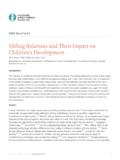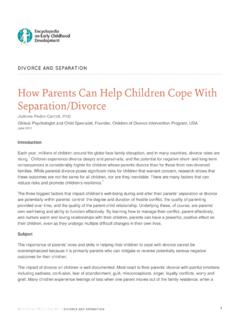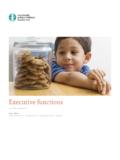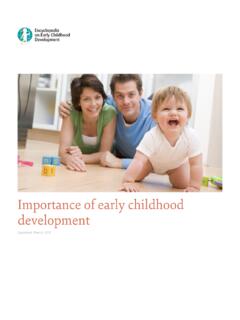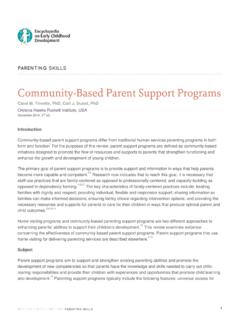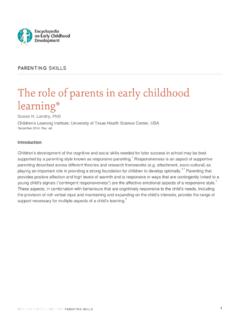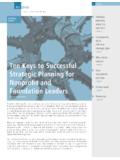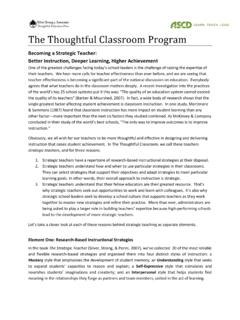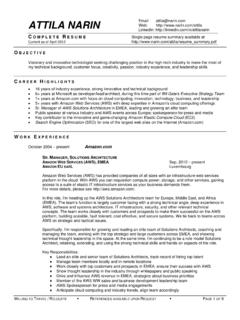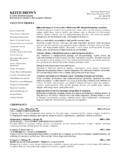Transcription of Parent-child attachment : A bond of trust
1 Eyes onA bond of trustParent-childattachment attachment is the emotional bond between you and your baby. Parent-child attachment 2008 - 2012 CEECD / SKC-ECDWhat do we know?n attachment is the emotional bond between you and your Your baby cannot speak, but he still has ways to let you know how he s feeling. If you pay attention to these signs and act on them to comfort your baby, you will form a bond of trust with him. n For example, your baby may cry when he is sick, tired or afraid. This is his way of letting you know that he wants to be comforted. n When you pay attention to your baby s crying and comfort him in these situations, he learns that you can protect him. He comes to know that you will act in a predictable and caring way when he needs you.
2 This makes him feel more trusting and more secure with You can see that your child has a strong bond of trust with you when he is happy around you and when he actively wants to be with you (for example, he smiles at you, wants to play and cuddle with you).n If your child grows up trusting you, he learns to trust other people in different When your child feels trusting and secure he is more likely to become independent. He is able to face the regular challenges of childhood (such as starting day care or making new friends) and other difficult situations. n If your child is trusting and secure, he is better able to control the way he reacts in situations that he finds scary or stressful. Being able to control his feelings is an important part of emotional and cognitive parents can be stressed due to problems with their couple, health or finances.
3 When they are stressed and also don t have much support or good bonding experiences of their own, they can find it hard to respond to their children in predictable and caring If parents find themselves in this situation often or for long periods of time, they may not be able to form a strong bond of trust with their child . This can lead to problems for the child , such as negative social behaviours ( , aggression) or psychological your baby s crying or other signs of discomfort, worry or distress. These are your baby s ways of letting you know he is not doing well and that he needs your the games your child likes to play and to signs that your child wants you to play with him.. your own signs of fatigue, stress and bond of trust 2008 - 2012 CEECD / SKC-ECDn Comfort your baby by responding quickly to any signs of discomfort or distress.
4 For example, be loving and caring, speak softly, and hold your baby in your Set up a care routine that is always the same (for example, baths and meals at fixed times, bedtime routines). This helps your child to learn to expect these events. It also helps you to keep the family Take a few minutes to hold your baby in your arms to talk and interact with him. This is a great way for you to get to know your Be aware of your child s play. Imitate what he does. Let your child lead the Offer some new ideas that might be fun. If he s getting frustrated, suggest solutions and congratulate him for his Plan time to play with your child without being in a hurry. Try not to think about other things that need to be Pay attention to signs that your child is getting tired of the game.
5 Let him stop the game if he s getting tired or Give yourself specific time to Share your child s care with your partner whenever possible. Get help from friends and family when you need it. n Find services in your community that can help (for example, babysitting networks, help with housekeeping, parents support groups or counselling services).Paying attention can be done?InformationThis Key Message is a publication of the Centre of Excellence for Early Childhood Development (CEECD) and the strategic Knowledge Cluster on Early child Development (SKC-ECD). These organizations identify and summarize the best scientific work on early childhood development. They disseminate this knowledge to a variety of audiences in formats and languages adapted to their a more in-depth understanding of attachment , consult our synthesis and experts articles on this topic in the Encyclopedia on Early Childhood Development, available free of charge at organizations financially support the CEECD and the SKC-ECD, including the Social Sciences and Humanities Research Council of Canada, Universit Laval, and private foundations.
6 The views expressed herein do not necessarily represent the official policies of these are grateful to the Fondation Lucie et Andr Chagnon for its financial contribution to produce this Key Message and to The Lawson Foundation for its financial support of this revised of Excellence for Early Childhood Development strategic Knowledge Cluster on Early child DevelopmentGRIP-Universit de Montr Box 6128, Succursale Centre-villeMontr al, Quebec H3C 3J7 Telephone: , extension 2541 Fax: : and this document, the masculine form is used merely to simplify the text. No discrimination is : Val rie Bell Claire Gascon Giard Kristell Le MartretCollaborators: M lanie Joly George Tarabulsy Isabelle Vinet (CPEQ)Copy editor: Lana CrossmanGraphic design: DesJardins Conception Graphique Inc.
